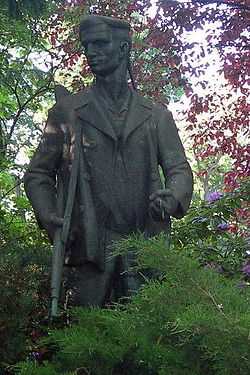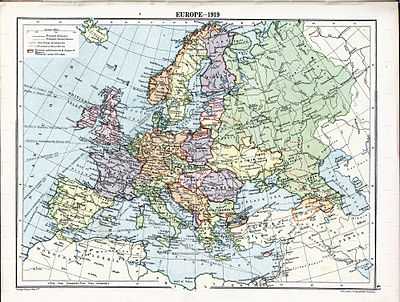Revolutions of 1917–23

The Revolutions of 1917–23 formed a revolutionary wave precipitated by the end of World War I in general and the Russian Revolutions of 1917 in particular. Some authorities date the wave as ending in 1919 or 1921.
Communist revolutions
Russia
In war-torn Imperial Russia, the February Revolution toppled the monarchy while the Bolsheviks seized power in the October Revolution. The ascendant communist party soon withdrew from war with Imperial Germany on the Eastern Front and then battled its political rivals in the Russian Civil War, including invading forces from the Allied Powers. In response to Lenin, the Bolshevik Party and the emerging Soviet Union, anti-communists from a broad assortment of ideological factions fought against them, particularly through the counterrevolutionary White movement and the nationalist Green Army, the various nationalist movements in Ukraine after the Russian Revolution and other would-be new states like those in Soviet Transcaucasia and Soviet Central Asia, through the anarchist-inspired Third Russian Revolution and Tambov rebellion. By 1921, faced with a trade boycott organised by the capitalist countries, exhaustion and starvation, even dissident elements of the Red Army itself were in revolt against the communist state, as during the Kronstadt Uprising. However the attempt at the restoration of the old feudal property relations and the pogroms which followed the victories by the White movement, together with solidarity actions with the workers' republic by workers abroad (such as the English dockers) were amongst the factors which facilitated reconquest by the once isolated and near exhausted Red Army, and led to the eventual defeat of the Whites and the imperialist intervention. The years of fighting subsequently spilled over the borders of the collapsed Russian Empire, as the Bolshevik regime virtually directed the formation of states such as the Mongolian People's Republic. In this process of revolution and counter-revolution the Union of Soviet Socialist Republics (USSR) was born in 1922.

Central Europe
The Leninist victories also inspired a surge by the world Communist movement: the larger German Revolution and its offspring, like the Bavarian Soviet Republic, as well as the neighboring Hungarian Revolution, and the Biennio rosso in Italy in addition to various smaller uprisings, protests and strikes, all proved abortive.
United States and elsewhere
They also provoked a severe backlash, including the First Red Scare in the United States and the collapse of economic liberalism in most nations of Central Europe, Eastern Europe and Southern Europe over the subsequent decade or so.
The Bolsheviks sought to coordinate this new wave of revolution in the Soviet-led Communist International, while new Communist parties separated from their former socialist organizations and the older, more moderate Second International. Despite ambitions for world revolution, the far-flung Comintern movement had more setbacks than successes through the next generation, until Soviet victory at the close of the Second World War brought a rapid multiplication of Communist states.
China
In Imperial China, the non-Communist 1911 Revolution had toppled the monarchy but failed to secure the new Republic of China. With Soviet approval, the nationalist party Kuomintang allied with the Chinese Communist Party to struggle throughout most of the warlord era for Chinese reunification (1928), until victory allowed the Chinese Nationalists and the Communists to turn on each other, precipitating the Chinese Civil War.
Non-Communist revolutions
Greece
In Greece, the site of several revanchist wars in the years prior to the First World War, the divided international loyalties of the political elite reached a crisis over that country's entry into the larger 1914–1918 conflict against its historic enemy, the Ottoman Empire. During what was known as the National Schism, a pro-Entente Powers, liberal and nationalist movement led by Eleftherios Venizelos struggled with the conservative and pro-German Empire monarch Constantine I for control. In the years immediately following, the new leadership waged the Greco-Turkish War (1919-1922), pursuing further irredentist territorial reconquest in a long succession of wars of national liberation.
Ireland
In Ireland, then ruled by the United Kingdom, the secessionist Easter Rising of 1916 anticipated the Irish War of Independence (1919–1921) within the same historical period as this first wave of communist revolution. The Irish republican movement of the time was predominantly nationalist and populist, and although it had left-wing positions and included Socialists and Communists, it was not Communist. The Irish and Soviet Russian Republics nevertheless found common ground in their opposition to British interests, and established a trading relationship.
Mexico
The same was true of the Mexican Revolution (1910–1920), which had broken out in 1910 but had devolved into factional fighting among the rebels by 1915, as the more radical forces of Emiliano Zapata and Pancho Villa lost ground to the more conservative "Sonoran oligarchy" and its Constitutional Army. The Felicistas, the last major group of counterrevolutionaries, abandoned their armed campaign in 1920, and the internecine power struggles abated for a time after revolutionary General Alvaro Obregon had bribed or slain his former allies and rivals alike, but the following decade witnessed the assassination of Obregon and several others, abortive military coup attempts and a massive right-wing uprising, the Cristero War, due to religious persecution of Roman Catholics.
Malta
The Sette Giugno of 1919 was a characterised by a series of riots and protests by the Maltese population, initially as a reaction to the rise in the cost of living in the aftermath of World War I. This led to the British forces firing into the crowd, killing four local men. The cost of living increased dramatically after the war. Imports were limited, and as food became scarce prices rose; this made the fortune of farmers and merchants with surpluses to trade.
Egypt
The Egyptian Revolution of 1919 was a countrywide revolution against the British occupation of Egypt and Sudan. It was carried out by Egyptians and Sudanese from different walks of life in the wake of the British-ordered exile of revolutionary leader Saad Zaghlul, and other members of the Wafd Party in 1919. The revolution led to Britain's recognition of Egyptian independence in 1922, and the implementation of a new constitution in 1923. Britain, however, refused to recognise full Egyptian sovereignty over Sudan, or to withdraw its forces from the Suez Canal Zone, factors that would continue to sour Anglo-Egyptian relations in the decades leading up to the Egyptian Revolution of 1952.
See also
Communist revolutions that started 1917-1924
- Bolshevik Revolution - USSR (1917–1991)
- Finnish Civil War (1918)
- Red Week (Netherlands) (1918)
- German Revolution (1918–1919)
- Bavarian Soviet Republic (1919)
- Hungarian Revolution (1919)
- Slovak Soviet Republic (1919)
- Biennio Rosso (1919–1920)
- Ruhr Uprising (1920)
- Labin Republic (1921)
- September Uprising (Bulgaria) (1923)
- Mongolian People's Republic - Mongolia (1924–1992)
Left-wing uprisings against the USSR
- Left SR uprising (1918)
- Left-wing uprisings against the Bolsheviks (1918-1922)
- Revolutionary Insurrectionary Army of Ukraine (1918-1922)
- Tambov Rebellion (1920-1921)
- Kronstadt Rebellion (1921)
Counter-revolutions against USSR that started 1917-1921
- White movement (1917–1923)
- Kuban People's Republic (1918–1920)
- Mountainous Republic of the Northern Caucasus (1917–1920)
- Democratic Republic of Georgia (1918–1921)
- Democratic Republic of Armenia (1918–1920)
- Azerbaijan Democratic Republic (1918-1920)
Soviet counter-counter-revolutions that started 1918-1919
- Russian Civil War (1917–1923)
- Red Terror (1918)
- Polish–Soviet War (1919–1921)
Related links
- Maps of Europe showing the Revolutions of 1917–23 at omniatlas.com